What You Should Know If You Have A Degenerative Knee


Written and verified by the doctor Gilberto Adaulfo Sánchez Abreu
We know that a degenerative knee is a chronic disease that causes pain and discomfort. In many cases, it can even cause incapacitation. That’s why a lot of doctors recommend surgery for a knee replacement.
Although genetics plays an important role, you can control a lot of other factors to lessen the damage. This means that through some lifestyle changes you can fight for your knee health.
What causes degeneration of the knee joint?
In many cases, genetics or hereditary diseases are to blame. In spite of this, lifestyle factors can affect genetics, especially when you’re placing extra stress on the joint. This is common if you have extra weight or bad exercise habits. In rare occasions, the degeneration does not appear to have any origin.
The most important factor in knee degeneration is arthritis. This chronic disease affects the degeneration of cartilage cells, increasing the degeneration of the joint.
Furthermore, if you’ve had an injury, it could affect your joints in the future. The degeneration of the knee caused by injury is also called “secondary arthritis” usually due to fractures or knee strains. These are often found in athletes or those suffering from obesity.
Nevertheless, despite its various origins, the symptoms of knee joint degeneration tend to be similar.
Read more: 5 Herbal Remedies for the Treatment of Arthritis
Symptoms of a degenerative knee
Once you already have degeneration, you may experience an alteration in the cartilage cells or even visible malformation.
In turn, this causes undesirable alignment and resistance in the joint. Moreover, this affects the elasticity of the cartilage, causing thinning and deterioration.

With this in mind, if you’re unsure about your knee health here are some warning signs to watch out for:
- Pain after long periods of standing, feeling of pinched nerves.
- Swelling or pain after walking over rocky or uneven flooring, such as after a long hike.
- Sharp pain while climbing steps that may even have resulted in a fall.
- Pain during standing after long periods of sitting.
- Crunching or popping of joints.
- Swelling. Don’t confuse this with water retention. Make a note if only one knee is swollen and/or if you have swelling elsewhere.
- Knee malformation. This can only be noticed in advanced stages, and it often causes your knees to turn inward due to cartilage damage.
- Bone spurs within the knee joint. Researchers have been looking at medications designed to prevent these, as it can cause severe pain and discomfort.
What if I’ve already been diagnosed?
First, after a diagnosis of a degenerative knee joint, you should start thinking about your lifestyle. Listen to your physician’s advice, and educate yourself on pain management. Likewise, it’s worth taking a look at the possible medication you might be taking. Those who suffer from a degenerative knee often live long and healthy lives, so don’t be afraid.
You might also like: 5 Exercises for Knee Pain
On the other hand, you can also think about getting a knee replacement. Replaced joints usually have a limited shelf life, so take into consideration your age and health.
Is it possible to prevent knee degeneration?
First, prevention is key. If you have a family history for knee degeneration, it doesn’t have to rule your life.
Second, be aware that cartilage can always regenerate. Living a healthy life can limit its loss while helping to rebuild it. Here are some things you can do:
- Watch your weight; maintain a healthy weight to lessen the stress on your joints.
- Boost your immune system. Make sure you get enough calcium, phosphorus and magnesium. Fruits and vegetables should be a major part of your diet.
- Eat a diet designed to help renew your cartilage. Make sure to include legumes, yeast, gelatin and eggs, as well as vitamin C.
- Don’t quit exercise; try swimming! It’s easy on the joints and good for your overall muscle and bone health.
Overall, by adjusting your lifestyle and making a few simple changes, you’ll notice your pain getting better. Remember that prevention and management are key to this condition.
All cited sources were thoroughly reviewed by our team to ensure their quality, reliability, currency, and validity. The bibliography of this article was considered reliable and of academic or scientific accuracy.
- Fransen, M., Mcconnell, S., Harmer, A. R., Van der Esch, M., Simic, M., & Bennell, K. L. (2015). Exercise for osteoarthritis of the knee. Cochrane Database of Systematic Reviews. https://doi.org/10.1002/14651858.CD004376.pub3
- Coggon, D., Reading, I., Croft, P., McLaren, M., Barrett, D., & Cooper, C. (2001). Knee osteoarthritis and obesity. International Journal of Obesity. https://doi.org/10.1038/sj.ijo.0801585
- Felson, D. T., Naimark, A., Anderson, J., Kazis, L., Castelli, W., & Meenan, R. F. (1987). The prevalence of knee osteoarthritis in the elderly. the framingham osteoarthritis study. Arthritis & Rheumatism. https://doi.org/10.1002/art.1780300811
- Heidari, B. (2011). Knee osteoarthritis prevalence, risk factors, pathogenesis and features: Part I. Caspian Journal of Internal Medicine.
This text is provided for informational purposes only and does not replace consultation with a professional. If in doubt, consult your specialist.








